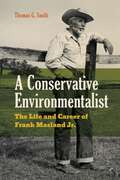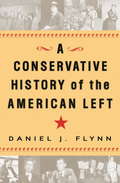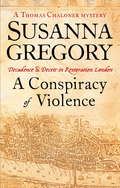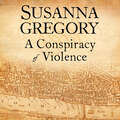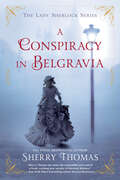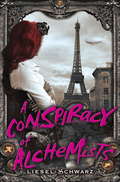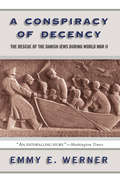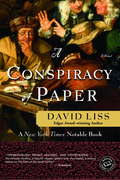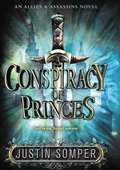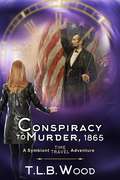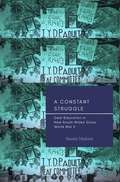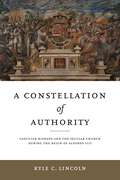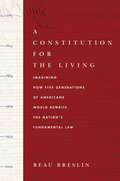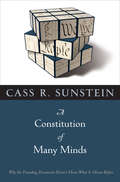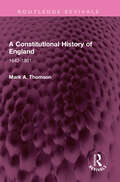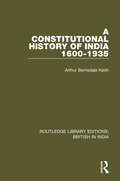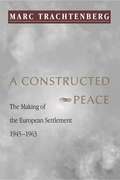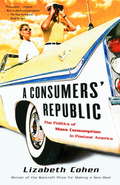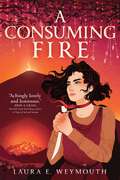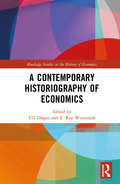- Table View
- List View
A Conquista de Natal (O Guia Essencial de uma Dama para a Arte da Sedução #1)
by Claire DelacroixO amor não fazia parte do plano quando este casamento foi arranjado… Rhys Bettencourt, Barão Trevelaine, pretendia, a todo custo, evitar a maldição da família. Um casamento arranjado com uma intelectual de fortuna deveria assegurar a produção de ao menos um herdeiro. Afinal, eram as esposas amadas pelos Bettencourt que sempre morriam no parto. Contudo, a prática Catherine minou o esquema do marido ao roubá-lo de seu coração. A única forma de Rhys protegê-la é negar satisfação física a ambos, indo contra seus próprios desejos. Catherine Carruthers contentou-se em se casar por praticidade e aceitou um casamento arranjado para agradar à família. No entanto, dois anos mais tarde, Catherine está certa de que o marido arrojado e aristocrata se arrepende da escolha que fez e que o casamento deles nunca será nada mais. Ela aceita um convite para passar o Natal na Mansão Rockmorton, e assim decidir se deixa Rhys e volta para a casa do pai. Contudo, ao chegar, Catherine descobre páginas de conselhos sensuais deixados no quarto dela, assim como um Rhys determinado a convencê-la a ficar. O casamento deles pode ser salvo? Armada com informações, e com pouco a perder, Catherine embarca em uma campanha de sedução que Rhys será impotente para resistir, mesmo que ele tema o destino de Catherine caso ele se renda à tentação. Preso entre o amor e uma maldição miserável, Rhys conseguirá encontrar um jeito de manter a querida esposa em segurança e ao seu lado? Com o epílogo bônus À Luz da Meia-Noite
A Conservative Environmentalist: The Life and Career of Frank Masland Jr.
by Thomas G. SmithA wealthy textile titan from Carlisle, Pennsylvania, Frank Masland Jr. was an ardent political conservative and an equally fervent conservationist who was well known and highly respected in the mid-twentieth-century environmental preservation community. This eye-opening biography charts Masland’s life work, telling the story of how he and fellow Republicans worked with Democrats to expand the national park system, preserve wild country, and protect the environment. Though a conservative conservationist appears to be a contradiction in terms today, this was not necessarily the case when Masland and his compatriots held sway. Conservatives, Masland insisted, had a duty to be good stewards of the earth for present and future generations, and they worked closely with members of both parties in Congress and nonpolitical conservation groups to produce landmark achievements. When conservatives turned against environmentalism during the Reagan presidency, Masland refused to join what historians have termed the “Republican reversal.” During his long life of nearly a hundred years, Masland used his voice, influence, experiences with nature, and considerable wealth to champion environmental causes at the national, state, and local levels. Engaging, informative, and at times eyebrow-raising, this portrait of a passionately anti-statist nature-loving Republican environmentalist documents the history of the twentieth-century conservation movement and reminds us of a time when conservative Republicans could work with liberal Democrats to protect the environment.
A Conservative History of the American Left
by Daniel J. FlynnFrom Communes to the Clintons-- Why does Hillary Clinton crusade for government-provided health care for every American, for the redistribution of wealth, and for child rearing to become a collective obligation? Why does Al Gore say that it's okay to "over-represent" the dangers of global warming in order to sell Americans on his draconian solutions? Why does Michael Moore call religion a device to manipulate "gullible" Americans? Where did these radical ideas come from? And how did they enter the mainstream discourse? In this groundbreaking and compelling new book, Daniel J. Flynn uncovers the surprising origins of today's Left. The first work of its kind,A Conservative History of the American Lefttells the story of this remarkably resilient extreme movement-one that came to America's shores with the earliest settlers. Flynn reveals a history that leftists themselves ignore, whitewash, or obscure. Partly the Left's amnesia is convenient: Who wouldn't want to forget an ugly history that includes eugenics, racism, violence, and sheer quackery? Partly it is self-aggrandizing: Bold schemes sound much more innovative when you refuse to acknowledge that they have been tried-and have failed-many times before. And partly it is unavoidable: The Left is so preoccupied with its triumphal future that it doesn't pause to learn from its past mistakes. So it goes that would-be revolutionaries have repeatedly failed to recognize the one troubling obstacle to their grandiose visions: reality. In unfolding this history, Flynn presents a page-turning narrative filled with colorful, fascinating characters-progressives and populists, radicals and reformers, socialists and SDSers, and leftists of every other stripe. There is the rags-to-riches Welsh industrialist who brought his utopian vision to America-one in which private property, religion, and marriage represented "the most monstrous evils"-and gained audiences with the likes of Thomas Jefferson, John Adams, and James Madison. There is the wife-swapping Bible thumper who nominated Jesus Christ for president. There is the playboy adventurer whose worshipful accounts of Soviet Russia lured many American liberals to Communism. There is the daughter of privilege turned violent antiwar activist who lost her life to a bomb she had intended to use against American soldiers. There are fanatics and free spirits, perverts and puritans, entrepreneurs and altruists, and many more beyond. A Conservative History of the American Leftis a gripping chronicle of the radical visionaries who have relentlessly pursued their lofty ambitions to remake society. Ultimately, Flynn shows the destructiveness that comes from this undying pursuit of dreams that are utterly unattainable. From the Hardcover edition.
A Conspiracy Of Violence: 1 (Adventures of Thomas Chaloner #1)
by Susanna GregorySusanna Gregory, author of the Matthew Bartholomew series of medieval mysteries, has created another compelling fictional detective set in Restoration London.--------------------------------------------The first adventure in the Thomas Chaloner series.The dour days of Cromwell are over. Charles II is well established at White Hall Palace, his mistress at hand in rooms over the Holbein bridge, the heads of some of the regicides on public display. London seethes with new energy, freed from the strictures of the Protectorate, but many of its inhabitants have lost their livelihoods. One is Thomas Chaloner, a reluctant spy for the feared Secretary of State, John Thurloe, and now returned from Holland in desperate need of employment. His erstwhile boss, knowing he has many enemies at court, recommends Thomas to Lord Clarendon, but in return demands that Thomas keep him informed of any plot against him. But what Thomas discovers is that Thurloe had sent another ex-employee to White Hall and he is dead, supposedly murdered by footpads near the Thames. Chaloner volunteers to investigate his killing: instead he is dispatched to the Tower to unearth the gold buried by the last Governor. He discovers not treasure, but evidence that greed and self-interest are uppermost in men's minds whoever is in power, and that his life has no value to either side.'Pungent with historical detail' (Irish Times)'A richly imagined world of colourful medieval society and irresistible monkish sleuthing' (Good Book Guide) 'Corpses a-plenty, exciting action sequences and a satisfying ending' (Mystery People)
A Conspiracy Of Violence: 1 (Adventures of Thomas Chaloner #1)
by Susanna GregorySusanna Gregory, author of the Matthew Bartholomew series of medieval mysteries, has created another compelling fictional detective set in Restoration London.--------------------------------------------The first adventure in the Thomas Chaloner series.The dour days of Cromwell are over. Charles II is well established at White Hall Palace, his mistress at hand in rooms over the Holbein bridge, the heads of some of the regicides on public display. London seethes with new energy, freed from the strictures of the Protectorate, but many of its inhabitants have lost their livelihoods. One is Thomas Chaloner, a reluctant spy for the feared Secretary of State, John Thurloe, and now returned from Holland in desperate need of employment. His erstwhile boss, knowing he has many enemies at court, recommends Thomas to Lord Clarendon, but in return demands that Thomas keep him informed of any plot against him. But what Thomas discovers is that Thurloe had sent another ex-employee to White Hall and he is dead, supposedly murdered by footpads near the Thames. Chaloner volunteers to investigate his killing: instead he is dispatched to the Tower to unearth the gold buried by the last Governor. He discovers not treasure, but evidence that greed and self-interest are uppermost in men's minds whoever is in power, and that his life has no value to either side.'Pungent with historical detail' (Irish Times)'A richly imagined world of colourful medieval society and irresistible monkish sleuthing' (Good Book Guide) 'Corpses a-plenty, exciting action sequences and a satisfying ending' (Mystery People)
A Conspiracy in Belgravia
by Sherry ThomasThe game is afoot as Charlotte Holmes returns in USA Today bestselling author Sherry Thomas’s Victorian-set Lady Sherlock series. Being shunned by Society gives Charlotte Holmes the time and freedom to put her extraordinary powers of deduction to good use. As “Sherlock Holmes, consulting detective,” aided by the capable Mrs. Watson, she’s had great success helping with all manner of inquiries, but she’s not prepared for the new client who arrives at her Upper Baker Street office. Lady Ingram, wife of Charlotte’s dear friend and benefactor, wants Sherlock Holmes to find her first love, who failed to show up at their annual rendezvous. Matters of loyalty and discretion aside, the case becomes even more personal for Charlotte as the missing man is none other than Myron Finch, her illegitimate half brother. In the meanwhile, Charlotte wrestles with a surprising proposal of marriage, a mysterious stranger woos her sister Livia, and an unidentified body surfaces where least expected. Charlotte’s investigative prowess is challenged as never before: Can she find her brother in time—or will he, too, end up as a nameless corpse somewhere in the belly of London?
A Conspiracy of Alchemists
by Liesel SchwarzLEAVE IT TO CHANCE. Eleanor "Elle" Chance, that is--the intrepid heroine of this edgy new series that transforms elements of urban fantasy, historical adventure, and paranormal romance into pure storytelling gold. In a Golden Age where spark reactors power the airways, and creatures of Light and Shadow walk openly among us, a deadly game of Alchemists and Warlocks has begun. When an unusual cargo drags airship-pilot Elle Chance into the affairs of the mysterious Mr. Marsh, she must confront her destiny and do everything in her power to stop the Alchemists from unleashing a magical apocalypse.n that even she scarcely suspects. Now she is about to meet her match in more ways than one: a handsome yet infuriating Warlock named Hugh Marsh, whose agenda is as suspect as his charms are annoyingly irresistible.
A Conspiracy of Decency: The Rescue of the Danish Jews During World War II
by Emmy E. WernerThe people of Denmark managed to save almost their country’s entire Jewish population from extinction in a spontaneous act of humanity – one of the most compelling stories of moral courage in the history of World War II. Drawing on many personal accounts, Emmy Werner tells the story of the rescue of the Danish Jews from the vantage-point of living eyewitnesses- the last survivors of an extraordinary conspiracy of decency that triumphed in the midst of the horrors of the Holocaust. A Conspiracy of Decency chronicles the acts of people of good will from several nationalities. Among them were the German Georg F. Duckwitz, who warned the Jews of their impending deportation, the Danes who hid them and ferried them across the Oresund, and the Swedes who gave them asylum. Regardless of their social class, education, and religious and political persuasion, the rescuers all shared one important characteristic: they defined their humanity by their ability to act with great compassion. These people never considered themselves heroes – they simply felt that they were doing the right thing.
A Conspiracy of Paper
by David LissTHE HISTORICAL THRILLER OF THE YEARBenjamin Weaver is an outsider in eighteenth-century London: a Jew among Christians; a ruffian among aristocrats; a retired pugilist who, hired by London's gentry, travels through the criminal underworld in pursuit of debtors and thieves.In A Conspiracy of Paper, Weaver investigates a crime of the most personal sort: the mysterious death of his estranged father, a notorious stockjobber. To find the answers, Weaver must contend with a desperate prostitute who knows too much about his past, relatives who remind him of his alienation from the Jewish faith, and a cabal of powerful men in the world of British finance who have hidden their business dealings behind an intricate web of deception and violence. Relying on brains and brawn, Weaver uncovers the beginnings of a strange new economic order based on stock speculation--a way of life that poses great risk for investors but real danger for Weaver and his family.In the tradition of The Alienist and written with scholarly attention to period detail, A Conspiracy of Paper is one of the wittiest and most suspenseful historical novels in recent memory, as well as a perceptive and beguiling depiction of the origin of today's financial markets. In Benjamin Weaver, author David Liss has created an irresistibly appealing protagonist, one who parlays his knowledge of the emerging stock market into a new kind of detective work.
A Conspiracy of Paper: A Novel
by David LissTHE HISTORICAL THRILLER OF THE YEARBenjamin Weaver is an outsider in eighteenth-century London: a Jew among Christians; a ruffian among aristocrats; a retired pugilist who, hired by London's gentry, travels through the criminal underworld in pursuit of debtors and thieves.In A Conspiracy of Paper, Weaver investigates a crime of the most personal sort: the mysterious death of his estranged father, a notorious stockjobber. To find the answers, Weaver must contend with a desperate prostitute who knows too much about his past, relatives who remind him of his alienation from the Jewish faith, and a cabal of powerful men in the world of British finance who have hidden their business dealings behind an intricate web of deception and violence. Relying on brains and brawn, Weaver uncovers the beginnings of a strange new economic order based on stock speculation--a way of life that poses great risk for investors but real danger for Weaver and his family.In the tradition of The Alienist and written with scholarly attention to period detail, A Conspiracy of Paper is one of the wittiest and most suspenseful historical novels in recent memory, as well as a perceptive and beguiling depiction of the origin of today's financial markets. In Benjamin Weaver, author David Liss has created an irresistibly appealing protagonist, one who parlays his knowledge of the emerging stock market into a new kind of detective work.
A Conspiracy of Princes (Allies & Assassins #2)
by Justin SomperThe newly crowned Prince Jared, ruler of All Archenfield, has inherited a kingdom in crisis. The murder of his older brother has revealed a traitorous plot in his court, calling into question who, if anyone, Jared can trust as he ascends the throne. Now the realm is on the brink of invasion from the brutal princes of Paddenburg and Jared must travel to neighboring kingdoms in search of allies to defend his throne. Little does he know that an even more dangerous plot is hatching in the Archenfield court--one that threatens to remove Jared from power. One put in motion by the very people he left in charge.The second book in Justin Somper's Allies & Assassins series delivers another twisted tale of high-stakes betrayal and political machinations set amid a lush medieval background.
A Conspiracy to Murder, 1865: Young Adult Time Travel Adventure (The Symbiont Time Travel Adventures Series #6)
by T.L.B. WoodPetra and Kipp discover the truth about the Lincoln assassination while investigating the government's hanging of Mary Surratt in the time-travel adventure, A Conspiracy to Murder, by T.L.B. WoodA flash of muzzle fire…a shot rings out…a president is dead…the fate of a nation is changed.Assisted by a shadowy group of conspirators—ultimately executed by the government—John Wilkes Booth assassinated Abraham Lincoln.Among the conspirators was Mary Surratt, who went to the hangman's scaffold along with three men.But was Mary Surratt truly guilty, or did she possess a secret?Petra, accompanied by her furry partner, Kipp, join forces with Peter and Elani to travel back in time to a war-torn nation to determine the truth. Their ability, due to their appearances as humans accompanied by their canine companions, allows them to go where others fear to tread. But when they get too close, they risk becoming suspects of the conspirators as well as the government. With authorities closing in, the quartet risks death and altering the future timeline as they struggle to escape with their lives and the truth intact. "I love the relationship between Petra and Kipp." ~ VM, verified reviewerTHE SYMBIONT TIME TRAVEL ADVENTURES,The SymbiontTombstone, 1881Whitechapel, 1888The Great Locomotive Chase, 1862Titanic, 1912A Conspiracy to Murder, 1865Robin Hood, 1192
A Constant Struggle: Deaf Education in New South Wales Since World War II
by Naomi MaloneDeaf education in New South Wales has made tremendous progress since the end of World War II, yet issues remain for students from their early years of education through secondary high school. Naomi Malone traces the roots of these issues and argues that they persist due to the historical fragmentation within deaf education regarding oralism (teaching via spoken language) and manualism (teaching via sign language). She considers the early prevalence of oralism in schools for deaf students, the integration of deaf students into mainstream classrooms, the recognition of Australian Sign Language as a language, and the growing awareness of the diversity of deaf students. Malone’s historical assessments are augmented by interviews with former students and contextualized with explanations of concurrent political and social events. She posits that deaf people must be consulted about their educational experiences and that they must form a united social movement to better advocate for improved deaf education, regardless of communication approach.
A Constellation of Authority: Castilian Bishops and the Secular Church During the Reign of Alfonso VIII (Iberian Encounter and Exchange, 475–1755)
by Kyle C. LincolnDuring the long reign of Alfonso VIII, Castilian bishops were crusaders, castellans, cathedral canons, and collegiate officers, and they served as powerful intermediaries between the pope and the king of Castile. In A Constellation of Authority, Kyle C. Lincoln traces the careers of a septet of these bishops and uses this history to fill in much of what really happened in thirteenth-century Castile.The relationships that local prelates cultivated with Alfonso VIII and the Castilian royal family existed in tension with how they related to the reigning pope. Drawing on diocesan archives, monastic collections, and chronicles, Lincoln reconstructs the complex negotiations and navigations these bishops undertook to maintain the balance among the papal and royal agendas and their own interests. Lincoln examines the bishops' ties to crusades and political influence, the growth of canon and Roman law, religious and church reform, and the canonization of local leaders. In the process, he makes the case that the medieval past is best illuminated by the combined luminescence of a “constellation of authority” represented, at least in part, by a conglomerate of bishops.Through seven case studies, each examining a prelate in his individual historical context, A Constellation of Authority improves our understanding of the politics of thirteenth-century Castile and provides an important foundation for further consideration of the ties between Castile and the broader European medieval world. It will appeal to medieval Hispanists and historians of the medieval church and episcopacy.
A Constitution for the Living: Imagining How Five Generations of Americans Would Rewrite the Nation's Fundamental Law
by Beau BreslinWhat would America's Constitutions have looked like if each generation wrote its own? "The earth belongs...to the living, the dead have neither powers nor rights over it." These famous words, written by Thomas Jefferson to James Madison, reflect Jefferson's lifelong belief that each generation ought to write its own Constitution. According to Jefferson each generation should take an active role in endorsing, renouncing, or changing the nation's fundamental law. Perhaps if he were alive today to witness our seething debates over the state of American politics, he would feel vindicated in this belief. Madison's response was that a Constitution must endure over many generations to gain the credibility needed to keep a nation strong and united. History tells us that Jefferson lost that debate. But what if he had prevailed? In A Constitution for the Living, Beau Breslin reimagines American history to answer that question. By tracing the story from the 1787 Constitutional Convention up to the present, Breslin presents an engaging and insightful narrative account of historical figures and how they might have shaped their particular generation's Constitution. Readers are invited to join the Founders in candlelit taverns where, over glasses of wine, they debated fundamental issues; to witness towering figures of American history, from Abraham Lincoln to Booker T. Washington, enact an alternate account through startling and revealing conversations; and to attend a Constitutional Convention taking place in the present day. These possibilities come to life in the book's prose, with sensitivity, verve, and compelling historical detail. This book is, above all, a call for a more engaged American public at a time when change seems close at hand, if we dare to imagine it.
A Constitution of Many Minds: Why the Founding Document Doesn't Mean What It Meant Before
by Cass R. SunsteinThe future of the U.S. Supreme Court hangs in the balance like never before. Will conservatives or liberals succeed in remaking the court in their own image? In A Constitution of Many Minds, acclaimed law scholar Cass Sunstein proposes a bold new way of interpreting the Constitution, one that respects the Constitution's text and history but also refuses to view the document as frozen in time. Exploring hot-button issues ranging from presidential power to same-sex relations to gun rights, Sunstein shows how the meaning of the Constitution is reestablished in every generation as new social commitments and ideas compel us to reassess our fundamental beliefs. He focuses on three approaches to the Constitution--traditionalism, which grounds the document's meaning in long-standing social practices, not necessarily in the views of the founding generation; populism, which insists that judges should respect contemporary public opinion; and cosmopolitanism, which looks at how foreign courts address constitutional questions, and which suggests that the meaning of the Constitution turns on what other nations do. Sunstein demonstrates that in all three contexts a "many minds" argument is at work--put simply, better decisions result when many points of view are considered. He makes sense of the intense debates surrounding these approaches, revealing their strengths and weaknesses, and sketches the contexts in which each provides a legitimate basis for interpreting the Constitution today. This book illuminates the underpinnings of constitutionalism itself, and shows that ours is indeed a Constitution, not of any particular generation, but of many minds.
A Constitutional Culture: New England and the Struggle Against Arbitrary Rule in the Restoration Empire (Early American Studies)
by Adrian Chastain WeimerIn A Constitutional Culture, Adrian Chastain Weimer uncovers the story of how, more than a hundred years before the American Revolution, colonists pledged their lives and livelihoods to the defense of local political institutions against arbitrary rule.With the return of Charles II to the English throne in 1660, the puritan-led colonies faced enormous pressure to conform to the crown’s priorities. Charles demanded that puritans change voting practices, baptismal policies, and laws, and he also cast an eye on local resources such as forests, a valuable source of masts for the English navy. Moreover, to enforce these demands, the king sent four royal commissioners on warships, ostensibly headed for New Netherland but easily redirected toward Boston. In the face of this threat to local rule, colonists had to decide whether they would submit to the commissioners’ authority, which they viewed as arbitrary because it was not accountable to the people, or whether they would mobilize to defy the crown.Those resisting the crown included not just freemen (voters) but also people often seen as excluded or marginalized such as non-freemen, indentured servants, and women. Together they crafted a potent regional constitutional culture in defiance of Charles II that was characterized by a skepticism of metropolitan ambition, a defense of civil and religious liberties, and a conviction that self-government was divinely sanctioned. Weimer shows how they expressed this constitutional culture through a set of well-rehearsed practices—including fast days, debates, committee work, and petitions. Equipped with a ready vocabulary for criticizing arbitrary rule, with a providentially informed capacity for risk-taking, and with a set of intellectual frameworks for divided sovereignty, the constitutional culture that New Englanders forged would not easily succumb to an imperial authority intent on consolidating its power.
A Constitutional History of England: 1642-1801 (Routledge Revivals)
by Mark A. ThomsonFirst published in 1938 A Constitutional History of England presents a comprehensive overview of various aspects and problems of English Constitutional history. Divided into six major parts it discusses important themes like parliament and the King; the period of the Restoration 1660-88; the revolution settlement 1689-1719; the age of conservatism 1720-1801; administrative developments 1660-1801; English local government; the problem of sovereignty; church and state; the forces of the Crown; and the press. This book is a must read for scholars and researchers of British history, and English Constitutional history.
A Constitutional History of India, 1600-1935: 1600-1935 (Routledge Library Editions: British in India #5)
by Arthur Berriedale KeithThis book, first published in 1936, provides a comprehensive description and analysis of every constitutional aspect of British rule in India from 1600 to 1936. Beginning with a description of the East India Company before Plassey, its constitution, administration of settlements, and relation to the Indian states, the book closes with an account of the reforms of the 1930s, the events leading up to the White Paper and an analysis and elucidation of the Government of India Act 1935.
A Constitutional History of the Kingdom of Eswatini (African Histories and Modernities)
by Hlengiwe Portia DlaminiSwaziland—recently renamed Eswatini—is the only nation-state in Africa with a functioning indigenous political system. Elsewhere on the continent, most departing colonial administrators were succeeded by Western-educated elites. In Swaziland, traditional Swazi leaders managed to establish an absolute monarchy instead, qualified by the author as benevolent and people-centred, a system which they have successfully defended from competing political forces since the 1970s. This book is the first to study the constitutional history of this monarchy. It examines its origins in the colonial era, the financial support it received from white settlers and apartheid South Africa, and the challenges it faced from political parties and the judiciary, before King Sobhuza II finally consolidated power in 1978 with an auto-coup d’état. As Hlengiwe Dlamini shows, the history of constitution-making in Swaziland is rich, complex, and full of overlooked insight for historians of Africa.
A Constructed Peace: The Making of the European Settlement, 1945-1963 (Princeton Studies in International History and Politics #79)
by Marc TrachtenbergPeople still think of the Cold War as a simple two-sided conflict, a kind of gigantic arm wrestle on a global scale," writes Marc Trachtenberg, "but this view fails to grasp the essence of what was really going on." America and Russia were both willing to live with the status quo in Europe. What then could have generated the kind of conflict that might have led to a nuclear holocaust? This is the great puzzle of the Cold War, and in this book, the product of nearly twenty years of work, Trachtenberg tries to solve it.The answer, he says, has to do with the German question, especially with the German nuclear question. These issues lay at the heart of the Cold War, and a relatively stable peace took shape only when they were resolved. The book develops this argument by telling a story--a complex story involving many issues of detail, but focusing always on the central question of how a stable international system came into being during the Cold War period. A Constructed Peace will be of interest not just to students of the Cold War, but to people concerned with the problem of war and peace, and in particular with the question of how a stable international order can be constructed, even in our own day.
A Consumers' Republic: The Politics of Mass Consumption in Postwar America
by Lizabeth CohenIn this signal work of history, Bancroft Prize winner and Pulitzer Prize finalist Lizabeth Cohen shows how the pursuit of prosperity after World War II fueled our pervasive consumer mentality and transformed American life.Trumpeted as a means to promote the general welfare, mass consumption quickly outgrew its economic objectives and became synonymous with patriotism, social equality, and the American Dream. Material goods came to embody the promise of America, and the power of consumers to purchase everything from vacuum cleaners to convertibles gave rise to the power of citizens to purchase political influence and effect social change. Yet despite undeniable successes and unprecedented affluence, mass consumption also fostered economic inequality and the fracturing of society along gender, class, and racial lines. In charting the complex legacy of our "Consumers' Republic" Lizabeth Cohen has written a bold, encompassing, and profoundly influential book.From the Trade Paperback edition.
A Consuming Fire
by Laura E. Weymouth&“Achingly lovely and luminous…left me completely enthralled.&” —Erin A. Craig, New York Times bestselling author of House of Salt and Sorrows Uprooted meets The Grace Year in this dark young adult fantasy of love and vengeance following a girl who vows to kill a god after her sister is unjustly slain by his hand &“that will appeal to readers of Leigh Bardugo and Holly Black&” (School Library Journal).Weatherell girls aren&’t supposed to die. Once every eighteen years, the isolated forest village of Weatherell is asked to send one girl to the god of the mountain to give a sacrifice before returning home. Twins Anya and Ilva Astraea are raised with this destiny in mind, and when their time comes, spirited Ilva volunteers to go. Her devoted sister Anya is left at home to pray for Ilva&’s safe return. But Anya&’s prayers are denied. With her sister dead, Anya volunteers to make a journey of her own to visit the god of the mountain. But unlike her sister, sacrifice is the furthest thing from Anya&’s mind. Anya has no intention of giving anything more to the god, or of letting any other girl do so ever again. Anya Astraea has not set out to placate a god. She&’s set out to kill one.
A Contagious Cause: The American Hunt for Cancer Viruses and the Rise of Molecular Medicine
by Robin Wolfe SchefflerIs cancer a contagious disease? In the late nineteenth century this idea, and attending efforts to identify a cancer “germ,” inspired fear and ignited controversy. Yet speculation that cancer might be contagious also contained a kernel of hope that the strategies used against infectious diseases, especially vaccination, might be able to subdue this dread disease. Today, nearly one in six cancers are thought to have an infectious cause, but the path to that understanding was twisting and turbulent. ?A Contagious Cause is the first book to trace the century-long hunt for a human cancer virus in America, an effort whose scale exceeded that of the Human Genome Project. The government’s campaign merged the worlds of molecular biology, public health, and military planning in the name of translating laboratory discoveries into useful medical therapies. However, its expansion into biomedical research sparked fierce conflict. Many biologists dismissed the suggestion that research should be planned and the idea of curing cancer by a vaccine or any other means as unrealistic, if not dangerous. Although the American hunt was ultimately fruitless, this effort nonetheless profoundly shaped our understanding of life at its most fundamental levels. A Contagious Cause links laboratory and legislature as has rarely been done before, creating a new chapter in the histories of science and American politics.
A Contemporary Historiography of Economics (Routledge Studies in the History of Economics)
by E. Roy Weintraub Till DüppeIn recent years, the focus of historians of economic thought has changed to also include the ideas and practices of contemporary economists. This has opened up new questions regarding the utilization of sources, choice of method, narrative styles, and ethical issues, as well as a new awareness of the historian’s place, role, and task. This book brings together leading contributors to provide, for the first time, a methodological overview of the historiography of economics. Emphasising the quality of the scholarship of recent decades, the book seeks to provide research tools for future historians of economic thought, as well as to any historians of social science with an interest in historiographic issues.

